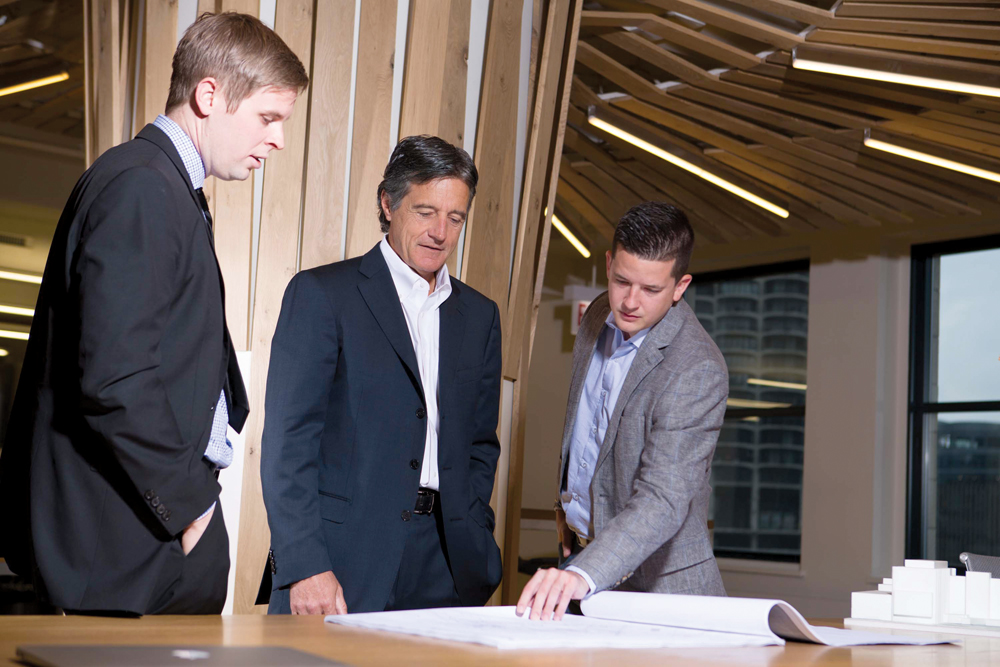Design-build firm Clayco has launched an investment arm called Treehouse Adventures to provide financing and operational infrastructure to startups, including those serving the AEC industry.
“We see a lot of opportunities in construction services,” says Michael Latiner, who joined Clayco last November as Treehouse’s President and Principal.
The goal is to create an environment where fledgling companies can concentrate on innovation and worry less about running a business. Clayco has dedicated the 14th floor of its headquarters in Chicago to provide space for the startups.
Treehouse’s first investment is Chicago-based Ventana Design-Build Systems, a five-month-old company that designs, supplies, and installs high-performance glass curtain wall façade systems. Latiner says Ventana’s President, Bob Trainor (center in photo, flanked by VPs Marty Trainor, left, and Ryan Murphy), was known in the business and had the ideas and processes, but needed Clayco’s operational backbone for support. “We were able to get them up and running in a week,” says Latiner.
Trainor says that Treehouse uses Clayco’s back-office services to provide marketing, IT, legal, and accounting support. It also provides an experienced senior management team and a network of relationships that startups like Ventana can leverage.
Treehouse doesn’t have a dedicated fund set aside for investment, but Latiner says he anticipates investing in two or three companies a year. A second deal has already been cut, with a technology startup whose expertise is making buildings smarter.
Read about more innovations from BD+C's 2014 Great Solutions Report.
Related Stories
| Nov 8, 2013
Oversized healthcare: How did we get here and how do we right-size?
Healthcare facilities, especially our nation's hospitals, have steadily become larger over the past couple of decades. The growth has occurred despite stabilization, and in some markets, a decline in inpatient utilization.
| Nov 8, 2013
Can Big Data help building owners slash op-ex budgets?
Real estate services giant Jones Lang LaSalle set out to answer these questions when it partnered with Pacific Controls to develop IntelliCommand, a 24/7 real-time remote monitoring and control service for its commercial real estate owner clients.
| Nov 8, 2013
S+T buildings embrace 'no excuses' approach to green labs
Some science-design experts once believed high levels of sustainability would be possible only for low-intensity labs in temperate zones. But recent projects prove otherwise.
| Nov 8, 2013
Net-zero bellwether demonstrates extreme green, multifamily style
The 10-unit zHome in Issaquah Highlands, Wash., is the nation’s first net-zero multifamily project, as certified this year by the International Living Future Institute.
| Nov 8, 2013
Walkable solar pavement debuts at George Washington University
George Washington University worked with supplier Onyx Solar to design and install 100 sf of walkable solar pavement at its Virginia Science and Technology Campus in Ashburn, Va.
| Nov 6, 2013
PECI tests New Buildings Institute’s plug load energy use metrics at HQ
Earlier this year, PECI used the NBI metrics to assess plug load energy use at PECI headquarters in downtown Portland, Ore. The study, which informed an energy-saving campaign, resulted in an 18 percent kWh reduction of PECI’s plug load.
| Nov 5, 2013
Net-zero movement gaining traction in U.S. schools market
As more net-zero energy schools come online, school officials are asking: Is NZE a more logical approach for school districts than holistic green buildings?
| Nov 5, 2013
New IECC provision tightens historic building exemption
The International Energy Conservation Code has been revised to eliminate what has been seen as a blanket exemption for historic buildings.
| Nov 5, 2013
Living Building Challenge clarifies net-zero definitions and standards
The Living Building Challenge has released the Net Zero Energy Building Certification to provide clearer definitions regarding what net zero really means and how it is to be achieved.
| Nov 5, 2013
Oakland University’s Human Health Building first LEED Platinum university building in Michigan [slideshow]
Built on the former site of a parking lot and an untended natural wetland, the 160,260-sf, five-story, terra cotta-clad building features some of the industry’s most innovative, energy-efficient building systems and advanced sustainable design features.

















